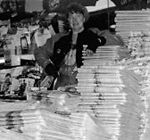“WHAT A GALLERY!” Steve Dunnington said, tugging at the lapels of his tuxedo and surveying the wildlife: gents with canes, ladies with walkers, street drunks, dozens of smiling wrinkled senior-class faces from the Pike Place Market neighborhood. Among a smattering of kids and post-yuppies, they danced along the clogged artery of the Read All About It newsstand at First and Pike. A table held one-layer cakes and a punch bowl. Overhead were balloons and wavy green and yellow streamers. A Cajun accordion and banjo duo, Fil頇umbo, strummed bluegrass in front of a Market retail shop. Its name provided the unintended caption for this marvelous picture: Pike Place Market Nuts. “My customers,” Dunnington murmured proudly.
It was the low-rent 20th birthday party of the corner newsstand partnered by Dunnington, 49, and Lee Lauckhart, 57. Steve’s the front office guy and Lee is out hawking on the corner, as was Seby Mahmias, their partner who died in 1987 and once peddled papers from all four corners of the Market crossroads.
As the museum of lined faces suggested, this was a party of history and survival, with expenses spared: The sign outside had the “15” in 15th birthday crossed out and replaced by 20. Images of those now living and dead flashed across a wrinkled sheet hanging in front of a slide projector set atop a step ladder—the dear departed including Eddie Spaghetti, Art Bauder and his dog Toto, Nick the wise guy, Mr. Wonderfreeze, and “Manuel, drunk in our neighborhood for 30 years.” Dunnington and Lauckhart, holding bouquets of flowers, watched with shiny eyes as the projector clicked away. “So many gone,” Lauckhart said.
But not this stand of gloss and newsprint where, it turns out, the computer and its ally in impersonal human relations, the Internet, have made the reading business better than ever. On October 25, 1979, the first newspaper and magazines were sold from the stand’s covered walk-around racks. Tons have been peddled since by vendors who make change from coins left sitting on the counter. Though daily paper sales have taken a dive in the past three years, “We’re doing good,” says Dunnington. “Magazine sales have gone up, balancing it out. The Internet has eaten into newspaper sales because papers are increasingly available online. Not so with magazines. Even when sales kind of plateau, prices are going up and people still buy.” Dunnington laughed. “It’s ironic. Computer and Internet magazines have become one of our biggest selling sections.”
“There are so many magazines,” chimes Lauckhart. “Back when we started, people told us computers would take over. Instead, they just produced the media in greater masses.”
High tech, then, is being used in the best way: to preserve a time when humans did not type their conversations to each other. Proof the old way is better was nearby, at the punch table. A wild-eyed man filling cups was saying, “Ten people made this punch.”
I tasted it. Good, I said; what do you call it?
He brightened, “The Ten People Made It Punch.”
Go hear that in a chat room.








